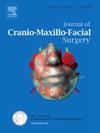利用锥形束 CT 评估骨骼微观结构,预测弹簧辅助颅畸形手术后头部形状的变化。
IF 2.1
2区 医学
Q2 DENTISTRY, ORAL SURGERY & MEDICINE
引用次数: 0
摘要
颅畸形(Craniosynostosis,CS)弹簧颅成形术后的头形变化很难预测。虽然先前的研究表明手术结果与体内颅骨微结构之间存在联系,但仍需要确定可应用于临床并有助于预测这些结果的成像生物标志物。在本研究中,从接受春季颅骨成形术的 CS 患者身上采集了 10 个顶骨样本(8 名男性,年龄为 157 ± 26 天)和 2 个枕骨样本(男性,年龄分别为 1066 天和 1162 天)。使用临床成像模式(牙科 CBCT、C 型臂 CT)和显微 CT 检查了样本的微观结构。通过测量颅骨指数(CI)来评估患者手术前后的头型,并研究其与形态测量的关系。C-arm CT(ρ = -0.857,p = 0.014)和 8.9 μm micro-CT(ρ = -0.857,p = 0.014)的骨横截面厚度(CsTh)与手术后 CI 的增加有显著相关性。此外,CBCT(ρ = -0.643,p = 0.013)、50 μm micro-CT(ρ = -0.857,p = 0.014)和 8.9 μm micro-CT(ρ = -0.857,p = 0.014)的骨量(BV)与 CI 增加相关。本文章由计算机程序翻译,如有差异,请以英文原文为准。
Cone beam CT for the assessment of bone microstructure to predict head shape changes after spring-assisted craniosynostosis surgery
Head shape changes following spring-cranioplasty for craniosynostosis (CS) can be difficult to predict. While previous research has indicated a connection between surgical outcomes and calvarial bone microstructure ex-vivo, there exists a demand for identifying imaging biomarkers that can be translated into clinical settings and assist in predicting these outcomes. In this study, ten parietal (8 males, age 157 ± 26 days) and two occipital samples (males, age 1066 and 1162 days) were collected from CS patients who underwent spring cranioplasty procedures. Samples’ microstructure were examined using clinical imaging modalities (dental CBCT, C-arm CT) and micro-CT. Cranial index (CI) was measured to evaluate patients' head shape before and after surgery, with an investigation into their relationship with morphometric measurements. Bone cross-sectional thickness (CsTh) showed significant correlation to CI increase post-SAC for C-arm CT (ρ = −0.857, p = 0.014) and 8.9 μm micro-CT (ρ = −0.857, p = 0.014). In addition, bone volume (BV) was correlated to CI increase for CBCT (ρ = −0.643, p = 0.013), 50 μm micro-CT (ρ = −0.857, p < 0.001) and 90 μm micro-CT (ρ = −0.679, p = 0.008). High correlation with micro-CT resampled to match respective voxel sizes was demonstrated for both CBCT and C-arm CT measurements of CsTh and BV (ρ ≥ 0.860, p < 0.001). This preliminary study demonstrates the potential of clinical CT devices to aid in pre-surgical decision making in CS.
求助全文
通过发布文献求助,成功后即可免费获取论文全文。
去求助
来源期刊
CiteScore
5.20
自引率
22.60%
发文量
117
审稿时长
70 days
期刊介绍:
The Journal of Cranio-Maxillofacial Surgery publishes articles covering all aspects of surgery of the head, face and jaw. Specific topics covered recently have included:
• Distraction osteogenesis
• Synthetic bone substitutes
• Fibroblast growth factors
• Fetal wound healing
• Skull base surgery
• Computer-assisted surgery
• Vascularized bone grafts

 求助内容:
求助内容: 应助结果提醒方式:
应助结果提醒方式:


